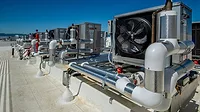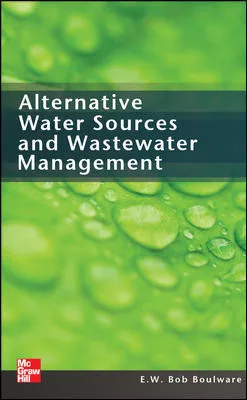Water Hammer Update
Engineering schools have been teaching students for decades that air chambers don't work. However, for some unknown reason, air chambers became the sacred cow of plumbing in many parts of the country.
The renewed interest is due to the fact that the manufacturers of water hammer arrestors are out there pushing the new code requirements. They are doing a good job educating the masses. Although I will admit that sometimes they push a little too hard. For example, if a system design is borderline as to whether to install a water hammer arrestor, they recommend that you install one. Heck, that is their job - to sell water hammer arrestors. Wouldn't you do the same thing?
Let's start from the beginning. With the publication of the 2000 model plumbing codes, water hammer requirements finally eliminated the concept of air chambers as we know it. Most plumbing technical schools were teaching apprentices to install a 1¿inch tube 12 inches long at each fixture water supply. That became the standard bearer. Both the International Plumbing Code and the National Standard Plumbing Code do not recognize the use of this air chamber.
The Uniform Plumbing Code took a slightly different approach. It left in the allowance for the use of an air chamber; however, it is not the standard 1¿inch by 12-inch air chamber that many in the profession are used to. The code was revised to require all air chambers to be accessible. Hence, you cannot enclose them in the wall. Each air chamber must have a means of recharging the air in the chamber. That means a valve at the top and a drain valve at the base.
Then a table was added for sizing the air chamber. If you have a 1¿inch pipe running 100 feet with a flowing pressure of 60 psi, the table requires an air chamber that is sized 1 inch by 69 1¿inches. You read that right, 69 1¿nches in length or 5 feet, 9 1¿inches. Not only that, the tubing size is 1 inch, not 1¿inch.
New View: What the table in the Uniform Plumbing Code demonstrates is how truly useless air chambers have been for all these years. So, what are you really supposed to do?
Every time I tell contractors that air chambers don't work, someone will challenge the concept and say, "I've been installing them in every building for the past 25 years and I don't have any water hammer problems." My immediate response is that if you removed the air chambers, you still wouldn't have a water hammer problem.
Water hammer, or hydraulic shock, as so aptly referred to by engineers, is caused by a number of factors. From an engineering standpoint, water hammer occurs when there is a conversion of energy. Flow water has kinetic energy; standing water has potential energy. When you change from kinetic (flowing) energy to potential (stationary) energy, it occurs in the form of hydraulic shock or water hammer.
Water hammer can be the result of high-velocity flow in the pipe, high pressure, high modulus of elasticity in the piping material or a quick change in velocity. Any one of these factors can cause water hammer. A combination can be extremely damaging to the piping system.
One of the often-overlooked factors is the high modulus of elasticity in the piping material. The plastic pipe manufacturers like this provision. If a water distribution system is designed for a maximum flow rate of 8 ft./sec., you will never need a water hammer arrestor for CPVC or PEX tubing. So, if you only install CPVC or PEX tubing, you don't have to read any further. Just realize, with this pipe or tubing, in simple terms, the hydraulic shock is absorbed by the material.
Hence, the real concern for water hammer is with copper tubing. However, you still would need a combination of factors for water hammer to be a problem requiring the installation of water hammer arrestors.
Quick Closing: The model plumbing codes indicate that when quick-closing valves are installed, a water hammer arrestor is required. The problem is that every code has a slightly different definition of quick-closing valves.
Dishwashers and washing machines always used to be considered as having quick-closing valves. However, newer dishwashers and washing machines have had the solenoid valves modified so that they do not close as quickly as previous appliances. Hence, they may not be considered as quick-closing.
Some codes say single-lever faucets are quick closing. Other codes say they are not quick closing. I have always thought I could make a single-lever valve quick closing. The same is true for a ball valve or push-pull valve.
It is not just a quick closing valve that causes water hammer. Any sudden change in velocity is a problem. If the water is flowing at 8 ft./sec. and quickly changes to flowing 2 ft./sec., the result is hydraulic shock. The question is, "How intense is the hydraulic shock?"
Every time there is a change in the velocity of flow, there is hydraulic shock. For purposes of the code, there is an established threshold whereby a water hammer arrestor is required. That threshold is a surge pressure of 150 psi.
This surge pressure cannot be measured with a pressure gauge. Since the pressure curve is traveling at the speed of sound, a standard pressure gauge won't even budge when the surge pressure hits. If you really wanted to measure the pressure you would need to install a pressure transducer.
One of the confusing aspects of water hammer arrestors is the number and placement of the arrestors. Every fixture does not need a water hammer arrestor. The normal effective range of a water hammer arrestor is 20 feet. That means that any fixture connected within the 20-foot distance is protected.
The best location for the water hammer arrestor is the last fixture downstream in the piping system (that requires protection). The 20-foot effective range is measured upstream from the water hammer arrestor, not downstream. While the shock wave is attempting to travel backward in the piping system, the flow of water is traveling into the water hammer arrestor. That is where the energy is absorbed.
When in doubt, establish in your own mind how fast the quick-closing valve will close. The quicker, the more problems you could have. When installing the water hammer arrestors, check out the smaller AA models. That is all you need for most residential applications. The larger valves are typically intended for commercial installations.
If you are still installing air chambers, stop what you are doing. If water hammer protection is really necessary, it can only be accomplished with the installation of a water hammer arrestor.
Looking for a reprint of this article?
From high-res PDFs to custom plaques, order your copy today!







